Saint Kjeld’s Kvarter by Tredje Natur
Architecture studio Tredje Natur is redesigning a Copenhagen neighbourhood to better handle the floods expected as climate change leads to fewer but heavier rain storms.
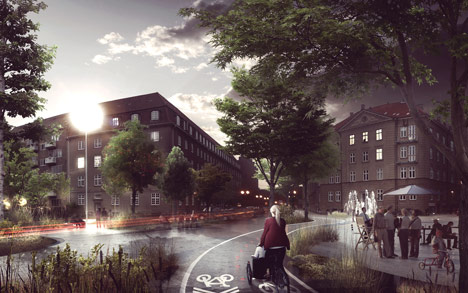
When heavy rainfall strikes Saint Kjeld’s Kvarter, the water will be collected above ground in parks and squares to simultaneously relieve the sewer systems and create new recreational areas around the pools.

A giant ring in the main square will spray out a cooling mist on hot days, while excess water will be channelled along new cycle lanes that will double as storm drains, leading to canals and out to the harbour rather than into people's basements.
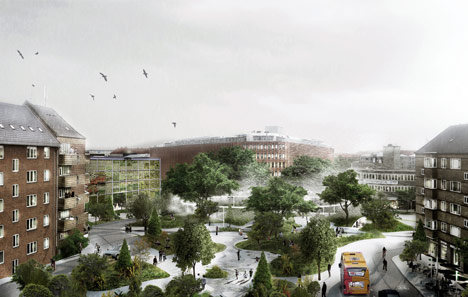
The architects and local government hope the scheme will become a model for green urban planning and a showcase for climate adaptation technology.
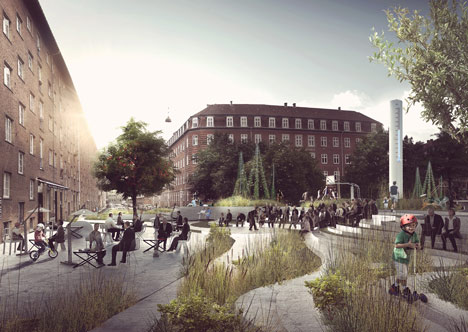
"Only last year, three cloud bursts cost the society over 5 billion DKK in damage to the buildings and infrastructure," says Flemming Rafn Thomsen, partner at Tredje Natur. "The climate adaptive plans in Copenhagen, and whole of Denmark really, are humongous and will probably have a time frame longer than 20 years, but the political will to get something done soon is pretty strong."
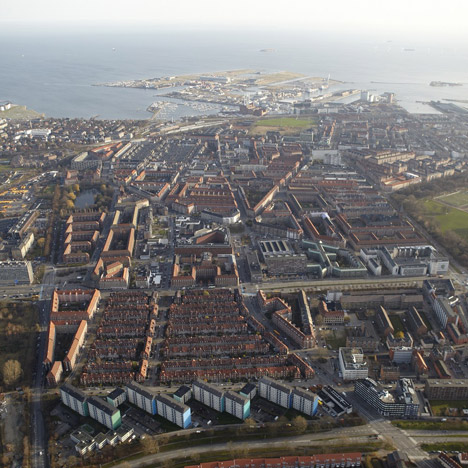
Flemming Rafn Thomsen and Ole Schrøder won the competition to re-design the site as part of the Europan architecture competition in 2011, after which the city of Copenhagen signed them up to advise on the strategic development of the area.
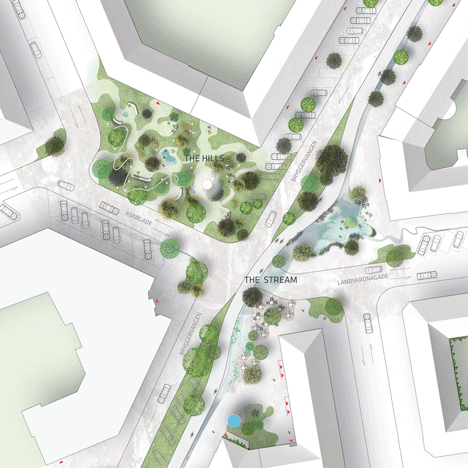
The detailed plans will be unveiled to Copenhagen residents tonight and construction is due to begin in 2013, with completion scheduled for 2015/16.
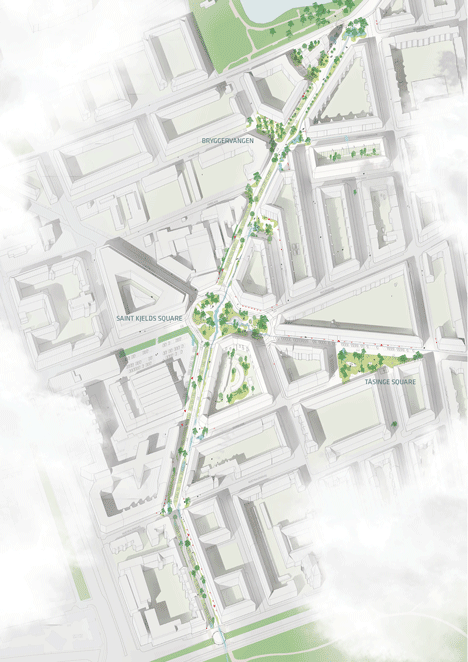
Click above for larger image
Here's some more information from Tredje Natur:
Copenhagen based architecture firm TREDJE NATUR develops Denmark's first climate adapted neighborhood.
On the 18th of August 2012 the plans for Copenhagen’s first climate adapted neighborhood is presented to the public. The project’s visions to transform Saint Kjeld’s Quarter into Copenhagen’s greenest neighborhood are presented at a grand opening by Danish Environmental Minister, Ida Auken,
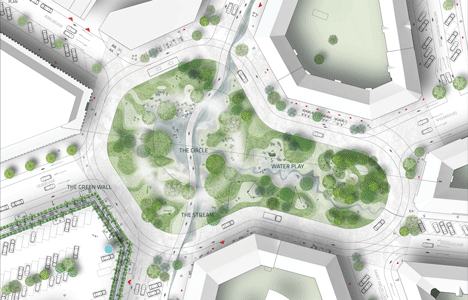
Click above for larger image
The climate is changing behavior. The Copenhageners can look forward to fewer but heavier rain showers, as the city has already been experiencing over the last two summers. In Saint Kjeld’s Neighborhood a comprehensive urban development project seeks to demonstrate how the city can be arranged so rainwater can be managed in the streets in a more natural and effective way. The project was designed by the newly established architectural firm TREDJE NATUR, and promotes new solutions for how we adapt to the climate changes and develop our cities.
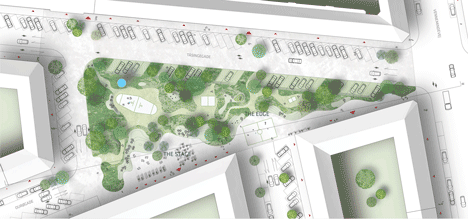
Click above for larger image
"The increase in rainfall is a major challenge for our city. But by tackling the challenge the right way, we can secure the city from cloudbursts while also bringing the city new recreational values. The ideas in Saint Kjeld’s Neighborhood are a really good example of this,” says Technical and Environmental Mayor of Copenhagen, Ayfer Baykal (SF).
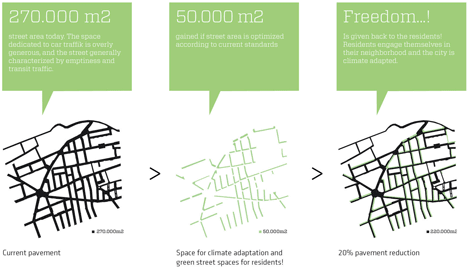
Click above for larger image
Pragmatic and Innovative Urban Development
TREDJE NATUR’s project offers a wide range of pragmatic strategies to meet the many expectations in the area. As a key principle the architects reclaim 20% of the street area by optimizing the infrastructure and parking lots according to current standard. The obtained area counts potentially 50,000 square meters and is to be used for new urban space development. It is also an important parameter not to compromise the city’s existing functions.
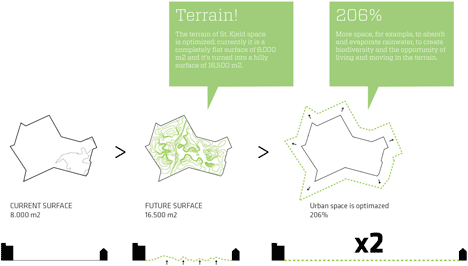
Click above for larger image
In the large urban spaces, such as Saint Kjeld’s Square and Tåsinge Square the office has put a great effort into creating new kinds of urban experiences founded in the city’s and nature’s changeability. A gigantic floating ring sprays a cooling rain mist out on the hot summer days, hundreds of plant species secures an attractive nature all year round and a hilly terrain invites you to play and stay.
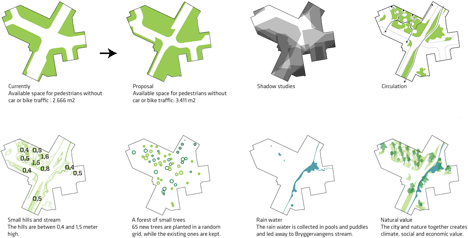
Click above for larger image
"At Saint Kjeld’s Square and Tåsinge Square we optimize the terrain effectively doubling the urban space’s surface area. This provides new space for a comprehensive volume of natural value, a better micro-climate and hence more urban life and better rain water management. The large spaces will be both striking and natural hot spots in the district. It is also possible to integrate new cafes and playgrounds in the optimized terrain," says Partner in TREDJE NATUR, Flemming Rafn Thomsen.
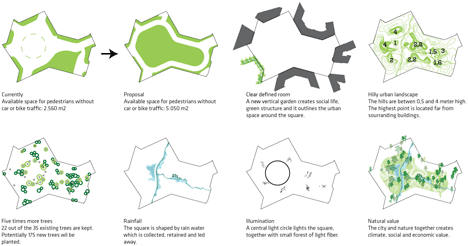
Click above for larger image
Naturally the water plays a particularly important role in the project. A key concept is the idea that the urban spaces are flooded when it rains and that the water remains in the urban spaces a little longer than usual. This relieves the sewer systems, and also helps to transform the experience and the use of the urban spaces.
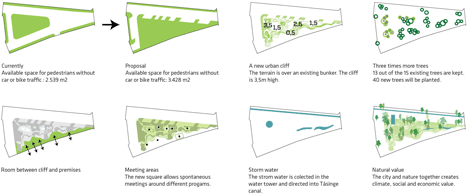
Click above for larger image
Copenhagen’s Greenest Neighborhood
The project introduces bicycle paths that act as storm water channels, water towers, green roofs, urban gardens, green houses and canals that carry water out from the neighborhood to the harbor. And simultaneously give rise to greater biological diversity in the city. These are just some of the ideas for new ways to adapt to the climate change that will emerge over the coming years. The City of Copenhagen plans to transform the densely populated neighborhood into a showcase area for climate adaptation technology. It is hoped to become a place that exhibits how we at one hand ensure our cities to future climate challenges, and moreover upgrade our urban spaces and streets significantly.

Click above for larger image
"By far the greatest challenges our society face lies in the existing city. The goal is to upgrade the city to residents' expectations as to how the city must perform in terms of sustainable, social and health related issues. Our key concepts are driven by the notion that a coherent and natural design creates the most powerful strategy and solution for the neighborhood as a whole, but also comprise a sensitivity to individual spaces, places and the people in the area," says partner in TREDJE NATUR, Ole Schrøder.

Click above for larger image
Adaptation to the climate changes should not only deal with larger sewers or rising taxes. Therefore, the project will instead operate with the city's visible surface and make the city greener, so that water is both delayed and the urban spaces are simultaneously transformed into wondrous places for the city's residents to hang out or exercise.

Click above for larger image
"In Copenhagen we must secure the city against the heavy rains we expect in the future," says City Architect Tina Saaby. "The projects in this neighborhood show how we at once can create beautiful, green streets and spaces and at the same time establish an effective technical solution that leads the rainwater in our streets to the harbor - instead of into our basements. It is architecture that integrates art and aesthetics in a new and very exciting way, "says Tina Saaby, City Architect of Copenhagen.
About TREDJE NATUR
In the latest edition of A10, the prestigious international architecture magazine, TREDJE NATUR is singled out as Shooting Stars together with 10 other young leading architectural practices in Denmark. The newly established office, based in Copenhagen, has experienced an impressive debut on to the Danish architectural scene. With a three-year scholarship awarded by The Danish Arts Council in 2011 Ole Schrøder and Flemming Rafn Thomsen realized the vision of a new architectural practice where the distinction between nature and architecture are revoked. TREDJE NATUR recently entered successfully into the final stage of the largest Danish planning competition in the City of Aalborg and is also shortlisted for the international competition on new major campus buildings in Kongsberg, Norway.
About Saint Kjeld’s Neighborhood
The architectural office TREDJE NATUR got the assignment in December 2011 by winning the European competition coalition EUROPAN11. The competition proposal comprised a visionary plan for how the district's streets and open spaces can become more diverse by letting the rain and natural phenomena merge with the urban life. In few years the neighborhood will be able to showcase the new solutions in real life and the ambition is to create a model area, which both nationally and internationally will inspire broadly and strengthen Denmark's position in urban water management and urban design.
The Opening Party is held at Tåsingegade in Copenhagen on Saturday the 18th August at 11 a.m. to 3 p.m. See The City of Copenhagen’s own website for more info.
Responsible Partners: Flemming Rafn Thomsen and Ole Schrøder
Design Team: Monica Galiana, Anna Sissela Michalsdottir, Joan Melgaard Rasmussen, Lotte Randeris Kristensen, Louise Fiil Hansen and Hans H. Bærholm
Location: Saint Kjeld’s Kvarter, Copenhagen.
Client: The City of Copenhagen
Size: 105 Ha
Project period: 2011-16